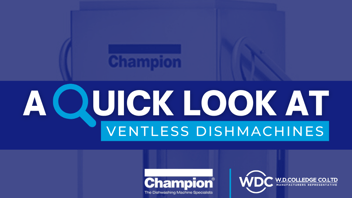Why You Should Consider a Ventless Commercial Dishwasher: An Honest Assessment

The bottom line is no matter what type of foodservice equipment, one solution is not always right for every type of operation.
Take commercial dishwashers, for example. While one type of operation might greatly benefit from a ventless unit, it might make no sense at all for another type of operation to go ventless. When deciding what type of warewasher is best for your needs, an honest assessment is required.
Let's compare the Champion 44-PRO unit with the 44-PRO Ventless Heat Recovery model.
There's no doubting the fact the ventless VHR unit can save an operation on both electric and water bills. The ventless unit will capture steam from a washing cycle, run it through a set of refrigerated coils, and convert that steam back to hot water while putting conditioned air of 70º F or lower back into the room.
By comparison, a non-ventless 44-PRO unit has vents on either side of the machine that will pull hot air out. That air then goes through exhaust ductwork and out of the building.
When you look at power and water usage of these two units side-by-side, a ventless unit can save on total operating costs by more than 50 percent annually when calculating daily operation for eight hours a day. But still, a ventless unit is not always the right choice.
When to Choose the Champion 44-PRO Non-Ventless Option
For operations where ductwork already exists, it might be more cost effective to choose a non-ventless commercial dishwasher. There are enormous costs with ductwork, so if those are eliminated, an operation should at least consider the 44-PRO.
Likewise, the 44-PRO Ventless Dishwasher also requires an appropriate ceiling height, so if the operation cannot accommodate the specified height, ventless might not be the best option, as well.
When to Choose the Champion 44-PRO VHR Ventless Option
The bottom line is if no ductwork is present and the space can accommodate the height of the VHR model, a ventless option is far more cost effective. They are great for new installs in large part because the additional ductwork can be eliminated, as well as all associated costs.
If it makes sense from a building design perspective, an operation can save on ventilation costs as well as utilities, and that makes for a faster return on investment.











